By Santorini Dave • dave@santorinidave.com
My Favorite Hotels in Lisbon
• 5-star: Avenida Palace
• 4-star: Torel Palace
• 3-star: LX Boutique Hotel
• For families: Chiado Flats
• For couples: Verride Palácio Santa Catarina
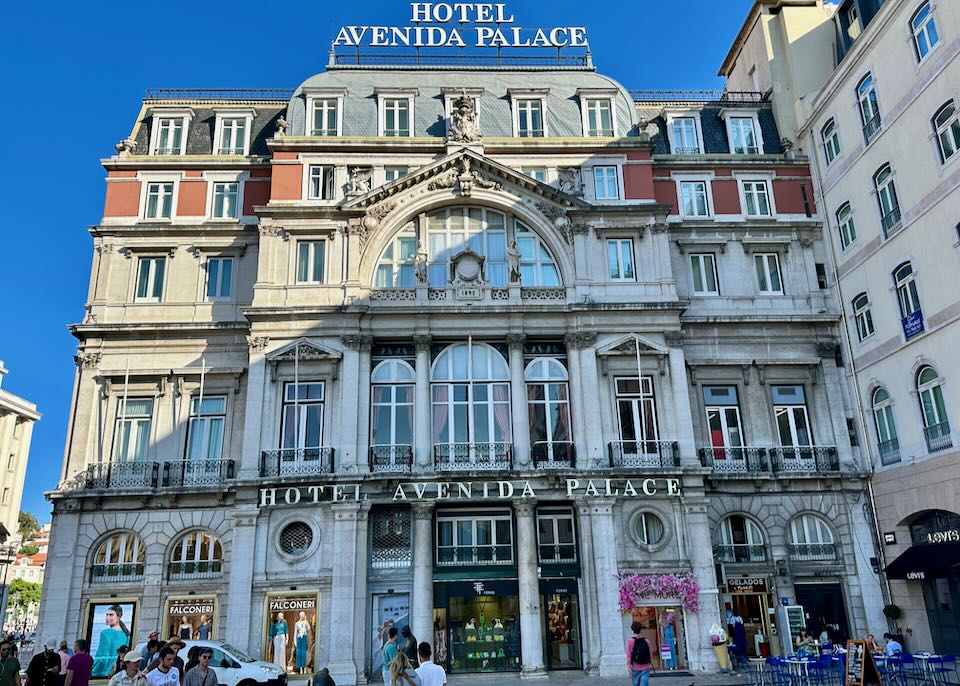
Our favorite luxury hotel in Lisbon is the historic 5-star Avenida Palace in the Baixa district, overlooking Restauradores Square.
The Best Areas to Stay in Lisbon
Lisbon has firmly established itself as one of Europe’s most captivating capitals. It offers a rare mix of old-world soul—tiled facades, yellow trams, and haunting Fado music—with a vibrant, modern energy. The city is built on seven steep hills overlooking the Tagus River, which means incredible “miradouro” (viewpoint) vistas are everywhere, but walking can be a workout. The climate is mild year-round, the food scene is booming, and despite its rising popularity, the hospitality remains genuinely warm.
Choosing the right neighborhood is critical because the districts are distinct and the hills impact navigability. Baixa and Chiado are the heart of the action; stay here for flat streets (in Baixa), grand plazas, and easy Metro access. Alfama is the oldest district; stay here for romance and history, but be prepared for steep steps and limited car access. Bairro Alto and Cais do Sodré are the nightlife hubs—fun for partying, but noisy for sleeping. For 5-star luxury and designer shopping, look to the tree-lined Avenida da Liberdade. If you prefer a calmer, resort-like vibe away from the crowds, Belém offers open space and river breezes, though it requires a 20-minute tram or taxi ride to reach the city center.
Lisbon Neighborhoods
Baixa is Lisbon’s historic downtown, located in the flat valley between the hills of Alfama and Bairro Alto. After the 1755 earthquake, it was rebuilt on a grand, easy-to-navigate grid. Just north is Rossio, the city’s bustling transport hub filled with traditional cafes and ginjinha bars. This area is the most “tourist-friendly” base because it is flat (a rarity in Lisbon) and central. Accommodation here ranges from luxury boutique hotels to solid mid-range options, though it can lack the local neighborhood feel found elsewhere.
On the hill directly west of Baixa lies Chiado, which slopes down toward the river. Chiado is the city’s elegant shopping and literary district, home to old-world bookshops, theaters, and historic cafes. Down by the water, Cais do Sodré has transformed from a gritty port area into one of the city’s hottest dining and nightlife hubs, anchored by the famous “Pink Street” and the Time Out Market. Chiado is perfect for upscale stays, while Cais do Sodré offers cool, edgy hotels—though it gets very loud on weekends.

A Lisbon tram in front of the Le Consulat Hotel, one of our top picks in the Chiado neighborhood.
Bairro Alto and Príncipe Real are the hilltop neighborhoods just above Chiado. Bairro Alto is the bohemian nightlife center; its narrow streets are sleepy by day but explode with bars and street parties at night. Príncipe Real, just to the north, is trendier and more sophisticated, filled with concept stores, gay bars, and leafy parks. It is currently one of the most desirable places to stay, offering chic boutique hotels and a quieter vibe than the raucous streets of Bairro Alto.
Avenida da Liberdade is Lisbon’s answer to the Champs-Élysées, a wide, tree-lined boulevard running northwest from Rossio. This is the undisputed home of 5-star luxury, housing the major designer fashion brands and the city’s grandest hotels. It is an excellent base for travelers who want space, quiet luxury, and easy Metro access, though it lacks the intimate, winding-street charm of the older districts.
Photogenic Alfama sits on the steep hill east of Baixa, crowned by the Castelo de São Jorge. This is Lisbon’s oldest district, a maze of medieval alleys, stairways, and whitewashed houses that survived the earthquake. It is the spiritual home of Fado music and incredibly romantic. However, staying here comes with logistical challenges: taxi access is difficult in the narrow streets, and you will be walking up and down steep hills constantly. Accommodations are mostly small boutique hotels and apartments.
Mouraria and Graça, located to the north and east of Alfama, offer the same historic atmosphere but with fewer tourists. Graça sits on the highest hill and boasts the city’s best viewpoints (miradouros), while Mouraria is the multicultural birthplace of Fado, full of soul and grit. These areas are fantastic for a more authentic “local” experience, though you will rely heavily on the famous Tram 28 or your own legs to get around.
Three miles west of the center, Belém is a spacious, monument-filled riverside district dedicated to Portugal’s Age of Discovery. It is home to UNESCO World Heritage sites like the Jerónimos Monastery and Belém Tower, as well as the famous Pastéis de Belém bakery. Between Belém and the center lie Alcântara (home to the hipster LX Factory complex) and Lapa (the posh embassy district). Belém is great for families wanting open space and resort-style hotels, but remember that you must take a train or taxi to reach downtown Lisbon.
Finally, Parque das Nações is the ultra-modern district built for the 1998 Expo, located near the airport about 6 miles (9km) north of the center. It feels like a different city, with futuristic architecture, the massive Vasco da Gama bridge, and a riverfront cable car. It is home to the spectacular Oceanário de Lisboa aquarium and many large business hotels. It is an excellent choice for families with young kids or business travelers, but it is far from the historic charm of Old Lisbon.

The streets of Lisbon are pedestrian friendly, but hilly.
Getting Around Lisbon Without a Car
1. Walking (The “Calçada” Warning)
Walking is the best way to see the historic center, as Baixa, Chiado, and Alfama are compact. However, you need to know two things:
• The Hills: They are steep and relentless. You will sweat.
• The Pavement: Lisbon is paved with beautiful limestone cobblestones (calçada portuguesa). They are incredibly slippery, especially when wet or worn smooth. Leave the high heels and flip-flops at home; wear shoes with serious grip.2. Ride-Sharing (Uber & Bolt)
Uber and Bolt are ubiquitous in Lisbon and surprisingly cheap compared to other European capitals. A ride across the city center often costs €4 to €6. If you are a group of 2 or more, taking an Uber is often cheaper and faster than buying Metro tickets. It’s the best way to get to the airport or outlying restaurants at night.3. Public Transport (Metro, Tram, Bus)
Lisbon has an excellent integrated network.
• The Metro: Clean, safe, and fast. It’s great for getting from the Airport to the City Center or for jumping between Baixa and Avenida da Liberdade. It does not go to Alfama or Belém.
• The Train to Belém: To visit Belém, take the suburban train (Linha de Cascais) from Cais do Sodré station. It takes 10 minutes and offers nice river views.
• Funiculars & Elevators: Use these to save your legs. The Gloria funicular (connecting Baixa to Bairro Alto) is iconic. Tip: Avoid the line for the Santa Justa Lift; instead, walk into the H&M store in Chiado and take the escalators down, or find the free public elevator near the Pingo Doce supermarket on Rua da Madalena to get up to the castle.4. How to Pay (The “Navegante” Card)
Do not pay cash onboard trams or buses; it costs nearly double (e.g., €3.10 vs €1.65).
• Go to any Metro station and buy a reusable paper card (Navegante Occasional, formerly Viva Viagem) for €0.50.
• Load it with credit using the “Zapping” option. This gives you the cheapest fare on all transport (Metro, Bus, Tram, Train, Ferry). One card per person is required.5. The Tram 28 Reality Check
The vintage yellow Tram 28E is legendary, connecting Martim Moniz (Mouraria) to Campo de Ourique. It’s a rolling museum through the narrowest streets of Alfama.
• The Warning: Between 10 am and 6 pm, it is incredibly crowded, with lines often exceeding an hour. It is also the #1 spot for pickpockets in Lisbon.
• The Strategy: Ride it before 8:30 am or after 8:00 pm. Alternatively, board at the Campo de Ourique terminus (the end of the line) where lines are much shorter than at Martim Moniz.
• The Alternative: Take Tram 24E from Chiado to Campolide. It uses the same vintage yellow cars but is far less crowded and climbs beautiful hills.The Best Places to Stay in Lisbon
- Best Luxury Hotels in Lisbon
Four Seasons Ritz • Avenida Palace • Memmo Príncipe Real • Verride Palácio Santa Catarina- Best Boutique Hotels in Lisbon
Le Consulat • Santiago de Alfama • Torel Palace- Best Cheap/Midrange Hotels in Lisbon
Chalet d’Ávila • Hall Chiado • LX Boutique Hotel- Best Hostels in Lisbon
Goodmorning Solo Traveller Hostel • Home Lisbon • Lisbon Destination • Lost Inn Lisbon • This is Lisbon • Yes LisbonBest Neighborhoods in Lisbon for…
- Best Neighborhoods in Lisbon for Sightseeing: Baixa and Rossio, Belém, Alfama
As the historic city center, Baixa and Rossio are full of attractions, such as the magnificent Praça do Comércio, the mini-Eiffel-Tower Elevador de Santa Justa, and the Rua Augusta, the restaurant and store-lined main drag. Belém has an amazing concentration of historic UNESCO-listed sights and top museums. Come here for the opulent Mosteiro dos Jerónimos, iconic Torre de Belém (from which Portuguese explorers set sail), fantastic contemporary art at Museu Coleção Berardo, and blinging carriages at Museu Nacional dos Coches. Alfama – Lisbon’s old town – is one big attraction, with its well-preserved Moorish-era streets, stark 12th-century cathedral Sé de Lisboa, and access to the majestic Castelo de São Jorge.Praça do Comércio is the spectacular entry point to Baixa & Rossio, Lisbon’s best areas for first-timers and for sightseers.
- Best Neighborhoods in Lisbon for Nightlife: Bairro Alto, Príncipe Real
There is no shortage of hip bars and thumping clubs in Lisbon – it’s rapidly becoming one of Europe’s party capitals. Head to São Vicente for Lux Frágil, one of the top clubs in the city, and don’t miss the famous Pink Street (Rua Nova do Carvalho) in Cais do Sodré, a parade of bars and restaurants that positively heaves with nighttime crowds – Musicbox and Pensão Amor are solid choices. But for an eclectic mix of craft beer, fine wine, slick cocktails bars, and sweaty clubs, go straight to Bairro Alto or the classier Príncipe Real. Popular bars in the former include Suave and Park Rooftop, with Lisbon institution A Capela the best place for dancing. In Príncipe Real, try Pavilhão Chinês, or 5A Club for the best DJs and cocktails.Remember that the Portuguese tend to eat late and party even later, especially at the weekends. Hip bars won’t start to get busy until midnight; they usually stay open till 3am or 4am (clubs usually till 6am at weekends).
- Best Neighborhoods in Lisbon for Families: Belém, Parque das Nações
Belém packs a lot of big attractions into a small area, including the innovative Museu de Arte, Arquitetura e Tecnologia (MAAT), and the spectacular Museu Nacional dos Coches. These are surrounded by parks and scenic riverside walks past romantic monuments to Portuguese explorers. There is also a cycle path along the river all the way to Cais do Sodré, and it’s a short train ride to the seaside at Cascais. Another good area is Parque das Nações: modern, more residential, and less raucous at night than some downtown areas. There’s plenty of shops and family-friendly restaurants (it’s extremely popular with local families at the weekends), plus the futuristic Oceanário aquarium, cable car (Telecabine Lisboa), Pavilion of Knowledge science museum, and the observation platform on the Torre Vasco da Gama, Lisbon’s tallest building.- Best Neighborhoods in Lisbon for Food and Restaurants: Chiado, Cais do Sodré
Lisbon is full of great dining options; just beware of tourist traps in Baixa and Alfama. Príncipe Real has a clutch of hot restaurants, with cuisines ranging from South Indian to Peruvian and Mexican. Avenida da Liberdade has some very chic restaurants. However, Chiado and Cais do Sodré have a bit of everything: gourmet street food at Mercado da Ribeira, the biggest market in the city (incorporating the excellent Time Out Market Lisbon); traditional Portuguese tascas, especially around Rua das Flores and Rua Nova do Carvalho; and exquisite fine dining at spots such as Bistro 100 Maneiras and Michelin-starred heavyweights Belcanto and Alma.Time Out Market Lisbon
- Best Neighborhoods in Lisbon to Stay for First Timers: Baixa and Rossio, Chiado, Alfama
If you are a newcomer, central Baixa and Rossio are great because they both have plenty of sights and atmosphere of their own and also because areas like Chiado, Bairro Alto, Alfama, and Avenida da Liberdade are a short walk (or climb) away. Chiado and Alfama are also great picks – both centrally located with a good mix of culture, historic character, cool shopping, and quieter residential areas. Choose Alfama if you want to immerse yourself in the oldest part of the city – it’s the one part of Lisbon that wasn’t devastated by the 1755 earthquake, so its Moorish and medieval roots are still intact.- Best Neighborhood for Shopping: Avenida da Liberdade
Lisbon’s Avenida da Liberdade is a designer paradise – this is where the city’s major boutiques are all located, from Gucci and Michael Kors to Louis Vuitton and Burberry. For indie stores, check out LxFactory in Santo Amaro, or the EmbaiXada mall in Príncipe Real. The best bargains can be had at the Feira da Ladra flea market at the eastern end of Alfama (held twice weekly). If you want to escape the tourists completely, head out to the Feira do Relógio on Sunday mornings (via Chelas metro station), to peruse Lisbon’s largest, no-frills market for cheap food, clothes, and local products.- Most Romantic Neighborhood in Lisbon: Alfama
There is almost no contest here; although places like Chiado and Príncipe Real boast sweeping views, elegant boutiques, and fine dining, Alfama is Lisbon at its most enchanting – and not just for its steep streets. Medieval alleys and stairways invite you to wander, miradouros (viewpoints) look out over red-roofed houses sloping down to the river, and there are hip bars and artisans’ workshops to discover as well as gorgeous boutique hotels to stay in. It can be crowded with tourists during the day, but at night, the castle walls are beautifully illuminated and the sound of fado can be heard from many traditional restaurants.- Best Areas in Lisbon for a Local Vibe: Mouraria and Graça
A few locals still live in Alfama and there is a traditional vibe despite the growing tourist crowds. Bairro Alto is the bohemian, uninhibited face of Lisbon, with its vintage shops, tattoo parlors, little tascas, and many unique bars packed into the narrow steeps. However, Mouraria and Graça are historic, characterful areas clustered north of Alfama, which have somehow remained working-class, immigrant-friendly, and relatively un-touristy. Unless you are willing to stay way out in north or west Lisbon, these are the best central neighborhoods to shake the tourist hordes. Mouraria is more diverse, drawing immigrants since its days as a Moorish ghetto in the 12th century, and has seen a little more urban renewal. Mingle with the locals in authentic Bangladeshi, Portuguese, Goan, or Mozambican restaurants, and discover local crafts, artists’ studios, and street art celebrating fado, which was born in Mouraria.- Best Areas in Lisbon for Walking: Avenida da Liberdade, Alfama
Lisbon is a pleasure to walk around, but a hilly one. Embrace the inclines and explore the winding streets of Alfama – there is really no other way to discover the treasures of this neighborhood. Mouraria and Graça have similar narrow streets which also reward leisurely wandering. Or stroll along broad, flat Avenida da Liberdade instead, taking in the grand arcade of plane trees and designer boutiques on either side. The center of the avenue has walking paths running all the way up to Parque Eduardo VII, lined with trees, flowers, and ponds, and on some days, the market stalls of Feira na Avenida.- Safety in Lisbon
Lisbon is in general a safe city with a low crime rate. In particular, Chiado, Baixa, Rossio, and Avenida da Liberdade are very safe. Tourists should simply take the usual precautions, e.g. watch their bags and stick to busy streets late at night.Busy areas and public transport that attract tourists tend to be places where pickpockets are a risk, so take care, especially around sights in Baixa and on trams 28E and 15E to Belém. At night, Cais do Sodré and Bairro Alto get loud and full of partygoers, while Martim Moniz and Intendente, just north of Mouraria, can feel sketchy.
The 8 Best Neighborhoods in Lisbon for Tourists
1. Baixa and Rossio
Baixa is Lisbon’s historic downtown and its elegant, bustling heart, with Rossio perched just to the north. Levelled by the 1755 earthquake, it was rebuilt (now quake-proof) by the Marquês de Pombal, funded by gold from Portugal’s colony of Brazil – its neat grid plan is a complete contrast to the winding, narrow roads of Alfama, just a short stroll away. Baixa’s busy streets are full of attractions, from the grand colonnades of Praça do Comércio in the south, where dignitaries to Lisbon used to land, to the cast iron filigree of Elevador de Santa Justa, built by Gustave Eiffel’s apprentice Raoul Mesnier – the ornamental elevator that whisks visitors (and locals) up to the slope to Chiado. There is plenty of shopping here, with high-end and edgier brands on offer, especially on Rua Augusta. Find great Portuguese restaurants and gourmet street food at Mercado da Baixa. Around Rossio (anchored by Praça Dom Pedro IV, aka Rossio Square) is the best place to find tiny ginjinha bars, for a taste of Lisbon’s iconic sour-cherry liqueur.
Rossio Square
This area has the widest range of accommodations, from high-end to hostels, for those who don’t mind the crowds. Baixa today is primarily a tourist area, though some businesses and government offices remain.
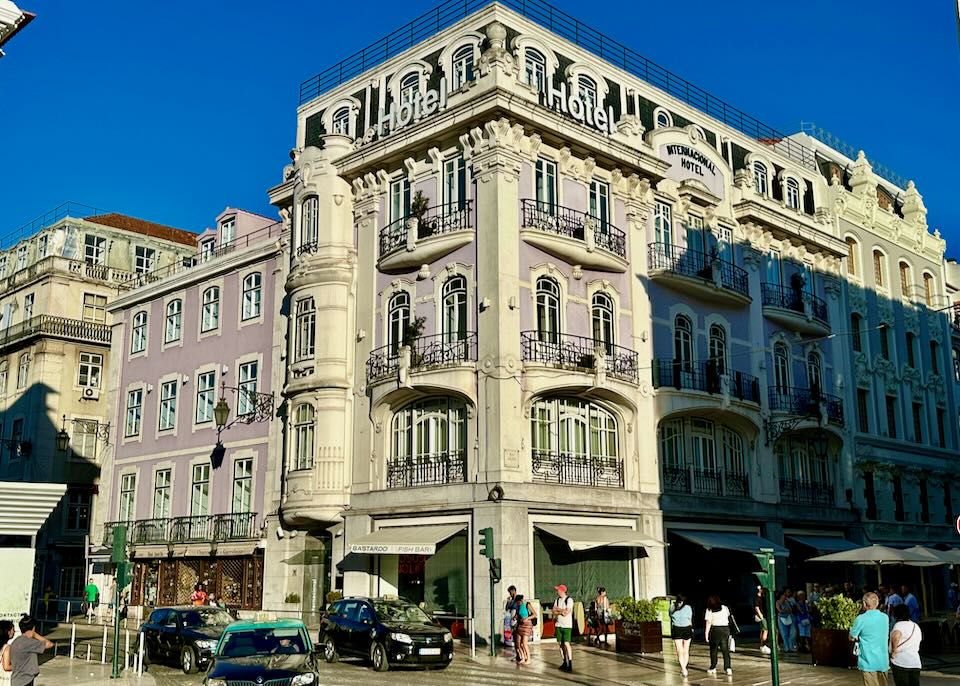
The centrally-located Internacional Design Hotel sits just off the south side of Rossio Square.
- Best Hotels in Baixa and Rossio
Avenida Palace • Hotel phone: +351 21 321 8100
Altis Avenida • Hotel phone: +351 21 044 0000
Hotel da Baixa • Hotel phone: +351 21 012 7450
Internacional Design Hotel • Hotel phone: Hotel Phone: + 351 213 240 990
Portugal Boutique Hotel • Hotel phone: +351 21 884 2120
Pousada de Lisboa • Hotel phone: +351 21 040 7640
Tesouro da Baixa • Hotel phone: +351 936 348 390- Best Cheap/Moderate Hotels
Art Inn • Hotel phone: +351 213 470 918
Be Poet Baixa Hotel • Hotel phone: +351 21 053 9300
Brown’s Boutique Hotel • Hotel phone: +351 21 342 0078
Tempo FLH Hotels • Hotel phone: +351 21 346 1250
Urbano FLH Hotels • Hotel phone: +351 21 887 0796- Best Hostels
Home Lisbon Hostel • Hotel phone: +351 21 888 5312
Lisbon Destination • Hotel phone: +351 21 346 6457
Living Lounge • Hotel phone: +351 21 346 1078
Yes Lisbon • Hotel phone: +351 21 342 71712. Chiado and Cais do Sodré
West of Rua Áurea in Baixa rises chic, historic Chiado, with edgier Cais do Sodré to the south, along the river. Chiado offers plenty of sightseeing, with its theaters and museums, including the ghostly Convento do Carmo ruins and Museu Nacional de Arte Contemporânea do Chiado, and literary landmarks like Livraria Bertrand (the world’s oldest bookstore, founded in 1732), and 19th-century Café A Brasileira (which features a statue of writer Fernando Pessoa sitting at a table).
Praça Luís de Camões
Fantastic shopping can be found here, particularly along Rua Garrett and central Praça Luís de Camões. The food scene is also hard to beat – Cais do Sodré’s main landmark is foodie magnet Mercado da Ribeira (home of Time Out Market Lisbon), while Chiado’s dining includes Belcanto, one of many restaurants by celebrated chef José Avillez, and Alma, both Michelin-starred. There are fine cocktail and wine bars such as Rove (in Le Consulat hotel) and Topo Chiado, but the undisputed nightlife destination is Cais do Sodré, on and around vibrant Rua Nova do Carvalho. Once a red-light district and now reborn as hipster Pink Street, unique bars like Sol e Pesca and Pensão Amor party till dawn.
There are some top hotels here, but also plenty of affordable options in Cais do Sodré (which tends to be noisier at night).
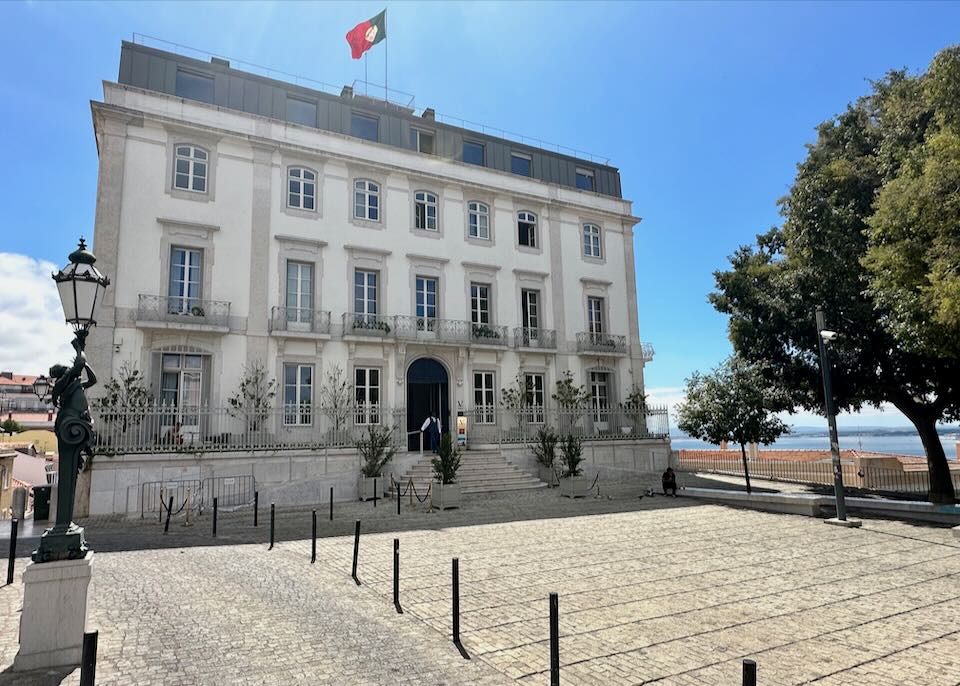
Verride Palácio Santa Catarina sits on a high perch in Chiado, with amazing views over the Lisbon rooftops to the sea.
- Best Hotels in Chiado and Cais do Sodré
Bairro Alto • Hotel phone: +351 21 340 8288
Casa Balthazar • Hotel phone: +351 91 708 5568
Corpo Santo • Hotel phone: +351 21 828 8000
The Ivens • Hotel phone: +351 21 054 3135
Le Consulat • Hotel phone: +351 939 316 530
Verride Palácio Santa Catarina • Hotel phone: +351 21 157 3055- Best Cheap/Moderate Hotels
Boho Guesthouse • Hotel phone: +351 932 648 200
Chiado Arty Flats • Hotel phone: +35 12 134 71564
Feeling Chiado 15 • Hotel phone: +351 21 347 0845
Hall Chiado • Hotel phone: +351 910 061 500
Hotel do Chiado • Hotel phone: +351 21 325 6100
LX Boutique Hotel • Hotel phone: +351 21 347 4394- Best Hostels
Lisbon Calling • Hotel phone: +351 968 159 426
Lisb’on Hostel • Hotel phone: +351 21 346 7413
Lost Inn Lisbon • Hotel phone: +351 21 347 07553. Bairro Alto and Príncipe Real
Bairro Alto, the ‘upper quarter’ north of Chiado’s Praça Luis de Camões, and Príncipe Real, further north from Rua Dom Pedro V and extending west, are young, trendy, and party-loving districts. The Bairro is alternative and graffiti-studded, while Príncipe Real is also arty but more affluent. Check out the art galleries, street art, and repurposed palaces on Rua Dom Pedro V, and catch memorable views from Miradouro de São Pedro de Alcântara. Other highlights include the Jesuit church of São Roque, with its stunning St John’s Chapel; the tropical Botanical Garden of Lisbon; and the family-friendly National Museum of Science & Natural History. Music fans might want to check out the Casa-Museu Amália Rodrigues, home and memorial to the famed fado singer and “Voice of Portugal”.
Miradouro de São Pedro de Alcântara.
Shop in Bairro Alto’s boho boutiques and Príncipe Real’s glossy designer ones like Kolovrat, and indie shopping mallslike EmbaiXada. Some of the hottest chefs in town have opened restaurants here, such as Ljubomir Stanisic at 100 Maneiras, and Francisco “Kiko” Martins at A Cevicheria. At night, Bairro Alto comes into its own, drawing crowds from across the city to cozy bars, sweaty dance floors, and terraces with a view. Meanwhile, Príncipe Real offers cool craft beer, wine, and cocktail joints to discover.
Accommodations in this area tend to be stylish guest houses, with some excellent hotels in Príncipe Real, but avoid Bairro Alto if you value quiet nights.
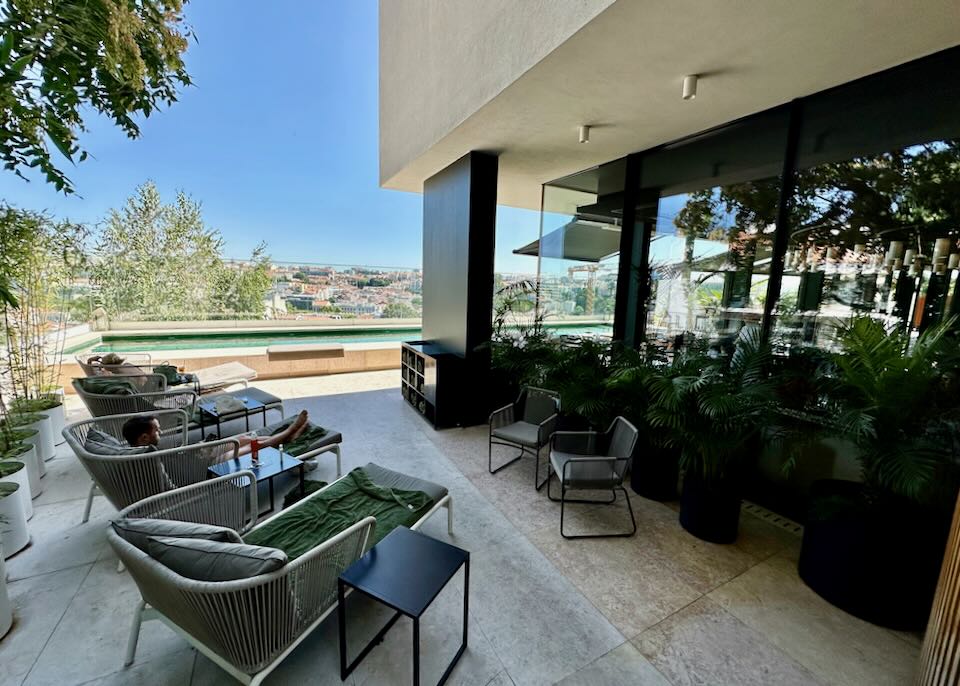
We love the cool, modern vibes at Memmo Príncipe Real.
- Best Hotels in Bairro Alto and Príncipe Real
Casa do Príncipe • Hotel phone: +351 935 743 078
Lumiares Hotel & Spa • Hotel phone: +351 21 116 0200
Memmo Príncipe Real • Hotel phone: +351 21 901 6800
Vintage Hotel & Spa • Hotel phone: +351 21 040 5400- Best Cheap/Moderate Hotels
Anjo Azul • Hotel phone: +351 21 347 8069
Casa de Sao Mamede • Hotel phone: +351 21 396 3166
Casa do Jasmim • Hotel phone: +351 918 517 146- Best Hostel
Independente Príncipe Real • Hotel phone: +351 21 346 13814. Avenida da Liberdade
Avenida da Liberdade is an affluent area northwest of Rossio and east of Príncipe Real. More modern and residential, its spine is the broad, leafy avenue itself, lined with plane trees and a glittering parade of luxury shops, from big names like Miu Miu and Armani to art galleries and boutiques like 39a Concept Store (on nearby Rua Alexandre Herculano). There are fewer big attractions here, but the avenue leads to the giant Marquês de Pombal traffic circle and Parque Eduardo VII, a pleasant green space home to the huge Estufa Fria greenhouse, modernist Monumento ao 25 de Abril, and the Miradouro Parque Eduardo VII, a viewpoint with spectacular views of the city center. The avenue also hosts the fanciest flea market in town, Feira na Avenida, held every second weekend of the month. You can find great fine dining here at venues like JNcQUOI Avenida, as well as some of Lisbon’s best cocktail bars, including Red Frog and Monkey Mash.
This is a good area for luxury hotels, though there are plenty of boutique, midrange, and budget options too. It lacks the atmosphere of the older city center neighborhoods, but on the plus side can feel a little divorced from the tourist hubbub.
- Best Hotels in Avenida da Libertade
Epic Sana Marquês • Hotel phone: +351 21 159 7300
Four Seasons Ritz • Hotel phone: +351 21 381 1400
Hotel Britania Art Deco • Hotel phone: +351 21 315 5016
Hotel Lisboa Plaza • Hotel phone: +351 21 321 8218
InterContinental Lisbon • Hotel phone: +351 213 818 700
Tivoli Avenida Liberdade • Hotel phone: +351 21 319 8900
Torel Palace • Hotel phone: +351 21 829 0810
Valverde Hotel • Hotel phone: +351 21 094 0300
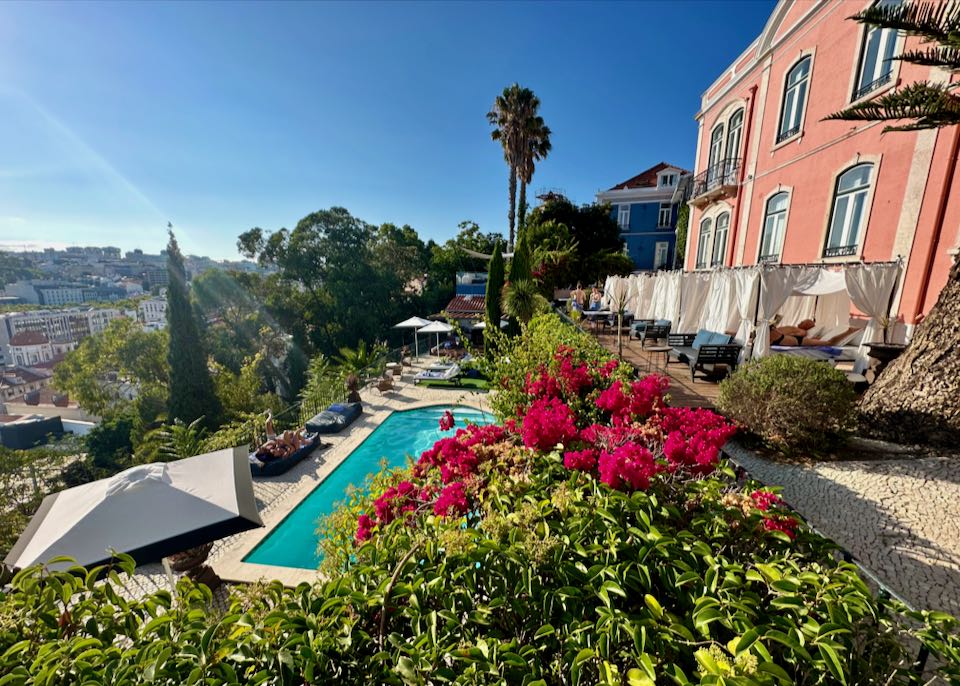
Looking over central Lisbon from the Torel Palace Hotel near Avenida da Liberdade.
- Best Cheap/Moderate Hotels
Alegria • Hotel phone: +351 21 322 0670
EVOLUTION Lisboa • Hotel phone: +351 211 590 200
Heritage Avenida Liberdade • Hotel phone: +351 21 340 4040
HF Fénix Music • Hotel phone: +351 21 049 6570
Hotel Portuense Lisboa • Hotel phone: +351 21 346 4197
Iberostar Selection • Hotel phone: +351 21 585 9000
Maxime Hotel • Hotel phone: +351 21 876 0000- Best Hostels
room00 Lisboa Hostel • Hotel phone: +351 21 249 6396
Goodmorning Solo Traveller Hostel • Hotel phone: +351 21 342 1128
Lisboa Central Hostel • Hotel phone: +351 309 881 0385. Alfama
As you ascend the hill from Baixa to Alfama, it feels as though you’ve crossed into an entirely different country. Distinct from Baixa’s post-1755 earthquake reconstruction, Alfama has preserved its narrow, medieval streets and buildings. As the oldest and most atmospheric district in Lisbon, Alfama’s charms have not gone unnoticed, attracting throngs of tourists throughout the year. However, tranquil streets and cozy cafés can still be found tucked away from the bustling crowds, inviting visitors to meander through the winding lanes and delight in getting lost.
Lisbon Cathedral
The primary sights here include Lisbon Cathedral (Sé de Lisboa), the Museu do Fado, and the old Moorish castle towering over all of it, the Castelo de San Jorge – you’ll get the best views of Alfama from the battlements. History buffs should checkout the Museu do Aljube Resistênciae Liberdade, chronicling the rise and fall of Portugal’s 20th-century dictatorship, housed in an old jail for political prisoners. There’s also the Panteão Nacional (National Pantheon) at the eastern end of the neighborhood, a shrine to Portuguese notables such as president Manuel de Arriaga, fado singer Amália Rodrigues, and soccer player Eusébio. Nearby are the Feira da Ladra and Mercado de Santa Clara (no-frills flea markets), and the Church of São Vicente de Fora, resting place of Portuguese royalty.
You can also shop for traditional crafts and mingle with locals at the numerous miradouros (viewpoints) and in the neighborhood cafes; fortunately, the influx of tourists has not yet gentrified the district completely. Eat in traditional tascas where fado singers perform, or seek out more modern takes on Portuguese food at Boi-Cavalo, Chapitô à Mesa, and Prado.
Accommodations in Alfama tend to be charming boutique hotels, with some guesthouses and budget options. Though compact, the neighborhood’s slopes can be steep – be prepared for a stiff hike.
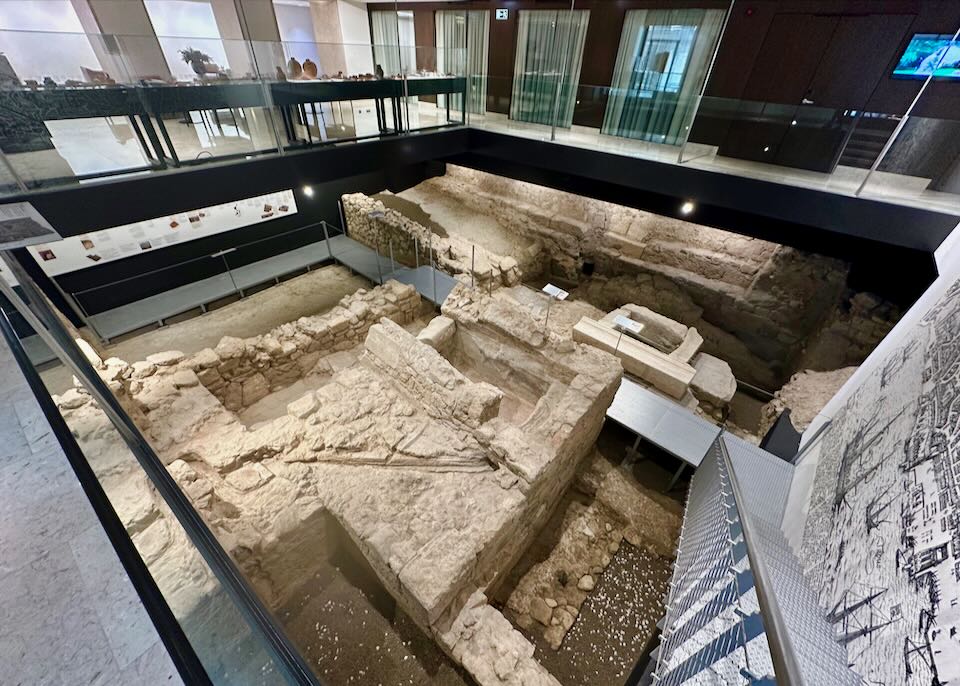
The 5-star Áurea Museum Hotel features a permanent archaeological exhibition, plus an indoor pool, massage room, and Turkish bath.
- Best Hotels in Alfama
Áurea Museum • Hotel phone: +351 21 116 6100
Palacete Chafariz d’El Rei • Hotel phone: +351 21 888 6150
Santiago de Alfama • Hotel phone: +351 21 394 1616
Solar do Castelo • Hotel phone: +351 21 880 6050- Best Cheap/Moderate Hotels
Hostel Petit Lusa • Hotel phone: +351 21 887 2773
Memmo Alfama • Hotel phone: +351 21 049 5660
São Vicente Alfama Hotel • Hotel phone: +351 21 048 8770
Solar dos Mouros • Hotel phone: +351 21 885 4940- Best Hostel
This is Lisbon • Hotel phone: +351 21 801 45496. Mouraria and Graça
Adjoining Alfama on its hill are two more historic neighborhoods worth exploring on foot – Mouraria on the northern slopes towards Martim Moniz, and Graça to the northeast. These are primarily working-class areas, full of local color and relatively undisturbed by tourism. Graça is Alfama’s more peaceful cousin, while Mouraria is both more multicultural and undergoing more regeneration. This “Moorish Quarter” is where the defeated Muslims were allowed to settle (outside the city walls) after the Siege of Lisbon in 1147; today you’ll find grocery stores and restaurants run by Bangladeshis, Chinese, Cape Verdeans, Mozambiquans, and many others, especially on Rua do Benformoso.
Stairway in Mouraria
Highlights here include the scenic viewpoints of Miradouro da Graça and Miradouro da Senhora do Monte, and contemporary art galleries like Hangar. There are great, affordable local restaurants – Mozambican cuisine at Cantinho do Aziz, Goan at Tentações de Goa, and Bangladeshi food at Spicy. At night, find a cool local bar, such as alternative Damas.
These are atmospheric areas that allow you to escape much of the tourist hubbub in neighboring Alfama. There are some gorgeous guesthouses and boutiques here, a couple of high-end hotels, and a spread of hip hostels.
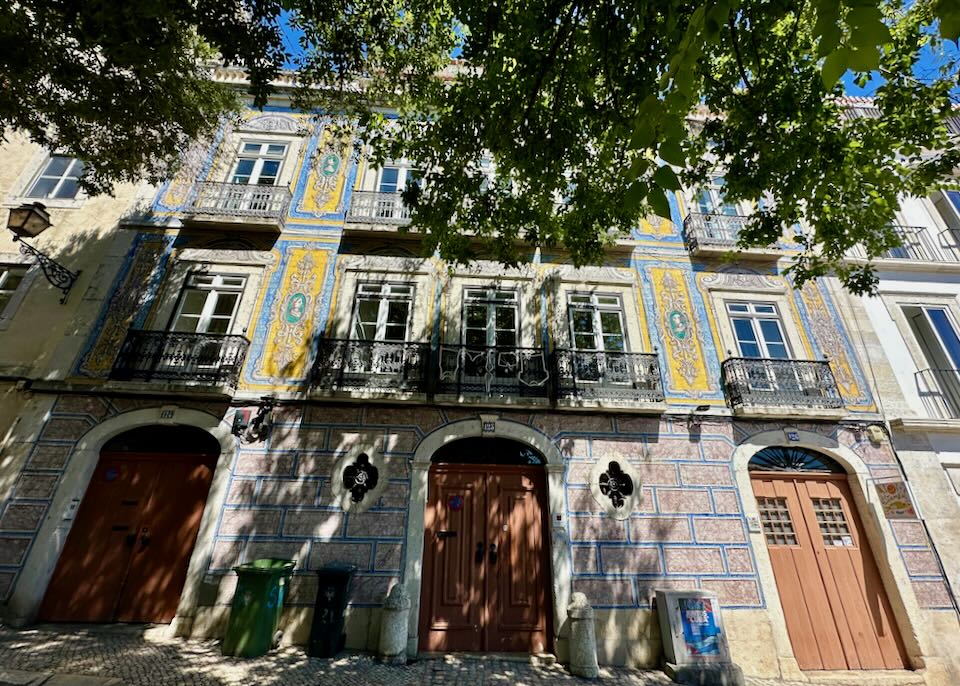
The colorful Casa dell’Arte Club House.
- Best Hotels in Mouraria and Graça
1908 Lisboa Hotel • Hotel phone: +351 21 880 4000
Casa dell’Arte Club House • Hotel phone: +351 968 851 513- Best Cheap/Moderate Hotels
Mouraria Lisboa Hotel • Hotel phone: +351 21 886 3900
Tings Lisbon • Hotel phone: +351 21 886 0160
WC by The Beautique Hotels • Hotel phone: +351 927 204 159- Best Hostels
Be Lisbon Hostel Intendente • Hotel phone: +351 937 526 654
Lisbon Poets Inn • Hotel phone: +351 21 346 1241
Sant Jordi Hostels Lisbon • Hotel phone: +351 21 014 6639
We Hate F Tourists • Hotel phone: +351 967 326 1847. Along the Tagus (Tejo): Belém, Lapa, Santo Amaro and Alcântara
Well away from the historic center (3 miles or a 30-minute tram ride west along the river from Baixa), Belém is a tourist magnet due to its major sights, scenic parks, and river views. It packs a great deal into a small area, from UNESCO-listed historic Mosteiro dos Jerónimos (a masterpiece of Manueline architecture) to one of Lisbon’s coolest museums, the Museu de Arte, Arquitetura e Tecnologia (aka “MAAT”). Belém is iconic Portugal – Torre de Belém is the site from which Portuguese explorers set sail, while Pastéis de Belém is the birthplace of the pastel de nata, the tasty custard tart (be prepared to wait in line for a table). The giant Padrão dos Descobrimentos (Monument to Discoveries) on the waterfront is another Lisbon icon. Museum-goers will enjoy the modern collection at the Museum of Contemporary Art, maritime history at Museu de Marinha, folk art at the Museu de Arte Popular, the home of the Portuguese President (with a small museum) at Palácio Nacional de Belém, and the modern Museu Nacional dos Coches, crammed with ornate horse carriages from the 16th century on. Stroll along the river to discover bars with a view, great seafood restaurants, and Michelin-starred dining at Feitoria.
The iconic facade of the Museum of Art, Architecture, and Technology (aka MAAT).
With more time it’s worth exploring the neighborhoods between here and the city center, beginning with Santo Amaro, where the Doca de Santo Amaro, a small marina, is lined with restaurants and bars offering stellar views of the Ponte 25 de Abril suspension bridge towering above. Inland, the LxFactory houses galleries, stores, and restaurants. Neighboring Alcântara is home to the Asian art collections at the Museu do Oriente, while wealthy Lapa is Lisbon’s diplomatic quarter, home to classical art in the Museu Nacional de Arte Antiga, and Portuguese puppets at Museu da Marioneta. On the riverfront, you’ll find more bars and restaurants in the regenerated district of Santos, plus clubs like Barrio Latino.
There are some heavy-hitter luxury hotels out here, as well as hip hostels and midrange options, all somewhat distant from the main tourist areas, though Belém can get extremely busy during the day.
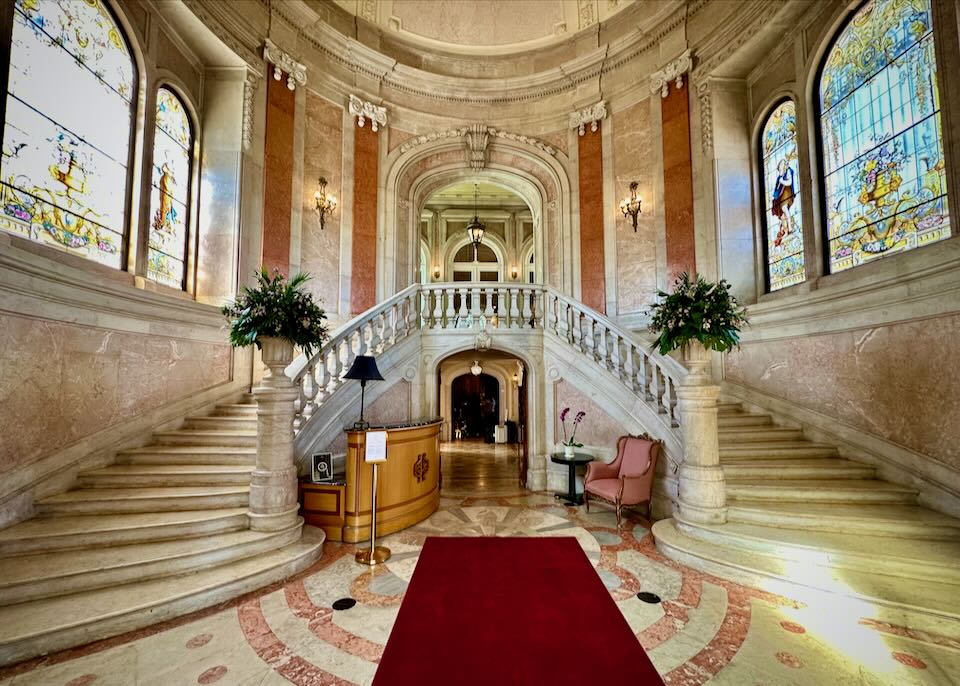
The Pestana Palace hotel is all about old world elegance and grandeur.
- Best Hotels along the Tagus
Altis Belém Hotel & Spa • Hotel phone: +351 21 040 0200
Emerald House Lisbon • Hotel phone: +351 21 150 6110
Olissippo Lapa Palace • Hotel phone: +351 21 394 9494
NAU Palácio do Governador • Hotel phone: +351 21 246 7800
Pestana Palace • Hotel phone: +351 21 361 5600
Wine & Books • Hotel phone: +351 21 156 6250- Best Cheap/Moderate Hotel
As Janelas Verdes • Hotel phone: +351 21 396 8143
C&O Guest House • Hotel phone: +351 960 086 544
Garam Lisboa Guesthouse • Hotel phone: +351 931 467 308
Gerónimo Guest House Belém • Hotel phone: +351 961 630 981
Jardim da Lapa • Hotel phone: +351 913 301 107- Best Hostels
LX Hostel • Hotel phone: +351 935 718 413
Terrace Lisbon Hostel • Hotel phone: +351 21 139 43288. Parque das Nações
The former Expo 98 site, 6 miles north along the Tagus estuary (or “Mar da Palha”) from the city center, has been transformed into the modern Parque das Nações district, a slick neighborhood of high rises, futuristic shopping malls, and a handful of primarily family-friendly sights, as well as a long, breezy promenade overlooking the Vasco de Gama Bridge, the second longest bridge in Europe (over 10 miles long). The main highlight is the stylish Oceanário aquarium, containing around 8,000 fish and marine animals; other attractions include a riverside cable car (Telecabine Lisboa), Jardins da Água (Water Gardens) and the Pavilion of Knowledge science museum, to numerous bars and restaurants and several major event venues such as the Altice Arena and Pavilhão de Portugal. It’s also possible to zip up to the observation platform atop the Torre Vasco da Gama, Lisbon’s tallest building. The main transport hub here, the Estação do Oriente, was designed by the star architect Santiago Calatrava.
Beato: In between Parque das Nações and Alfama lies the up-and-coming riverside neighborhood of Beato, where you’ll find popular seafood and Portuguese restaurants such as Casa do Bacalhau, as well as galleries like Manicómio Lisboa and the illuminating Museu Nacional do Azulejo, a dedicated to Portugal’s beautiful painted tiles.
There are lots of excellent, new hotels here, and the metro link is quite convenient, but it’s not an especially atmospheric place to stay unless your main focus is the aquarium and associated kid-friendly sights.
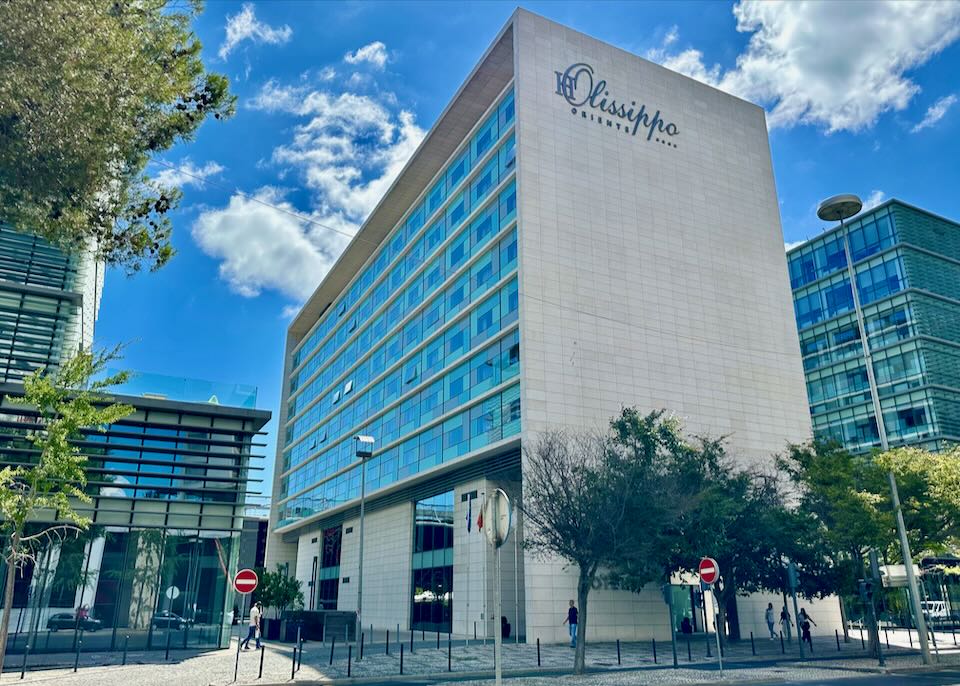
Olissippo Oriente Hotel is super close to the Oriente metro station, making transport into the city center quick and easy.
- Best Hotels near Parque das Nações and Beato
Myriad By Sana • Hotel phone: +351 21 110 7600
Olissippo Oriente Hotel • Hotel phone: +351 21 892 9100- Best Cheap/Moderate Hotels
Moxy Lisboa Oriente • Hotel phone: +351 21 048 8350
Tivoli Oriente Hotel • Hotel phone: +351 21 891 5100More Lisbon Neighborhoods
We’ve covered our favorite neighborhoods to visit and stay in more detail above, but with more time these districts are also worth checking out.
- North Lisbon: There are a few sights worth seeking out north of Parque Eduardo VII, with the standout attraction the Museu Calouste Gulbenkian, a must for art lovers. To the northwest lies the family-friendly Jardim Zoológico de Lisboa, aka Lisbon Zoo, and the Estádio da Luz, the soccer stadium of Benfica, one of Europe’s most celebrated football clubs. The club offers stadium tours and has a museum paying homage to legendary ex-players like Eusebio. Rivals Sporting Lisbon (officially Sporting Clube de Portugal) play at Estádio José Alvalade, a mile-and-a-half away, with their own museum and store. You can reach most of these places easily via public transport so there’s no need to stay the night up here, even if you get tickets for an evening match. If you do plan to spend the night, we recommend Chalet d’Ávila Guest House
- West Lisbon: West of the Bairro Alto lies the upscale district of Estrela, best known for its gardens and the enormous Basílica da Estrela (which houses the tomb of Queen Maria I, and Joaquim Machado de Castro’s lauded 18th-century cork and terra cotta nativity sculpture). Adjoining Campo de Ourique is an attractive, less touristy neighborhood home to an excellent indoor market and the Casa Fernando Pessoa, a museum dedicated to Portugal’s most beloved writer and poet (this house is where Pessoa lived from 1920 until his death in 1935). The inland neighborhoods further west contain a couple of sights that might appeal to long-stay or repeat visitors: the stately Palácio Nacional da Ajuda (a beautifully restored 19th-century royal palace) and the Palácio Nacional e Jardins de Queluz, a former royal summer palace surrounded by scenic gardens.
- South of the River: Other than a series of sandy Atlantic beaches, there’s not much to see south of the Tagus River, but it’s worth taking a ferry (or a bus over the Ponte 25 de Abril) to visit the Cristo Rei (Christ the King) statue, inspired by Rio’s famous Christ the Redeemer. It’s possible to ride an elevator to the deck at the base (269ft up) for sensational views across the city.
- There’s not much point in staying near Lisbon Airport in the northeastern part of the city unless you have a very early flight (it’s an easy taxi or metro ride from the city center). If you do need to stay here, the best hotel is the expensive but convenient Melia Lisboa Aeroporto, with the cheaper (and nearby) Star Inn a solid alternative.
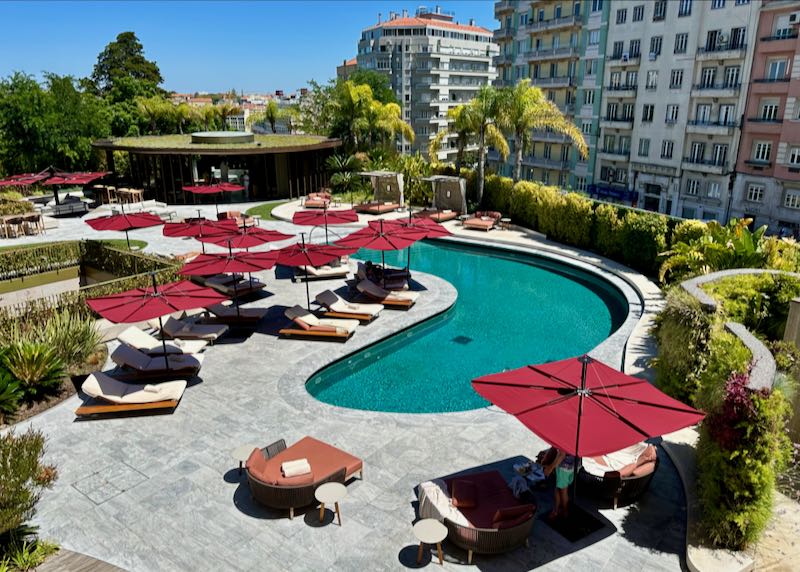
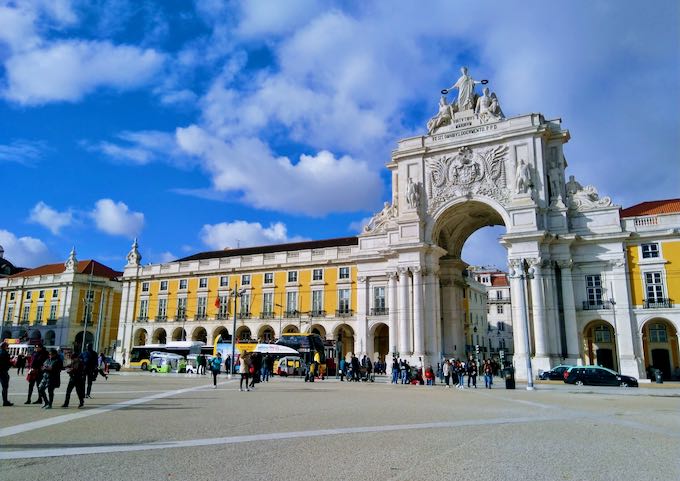
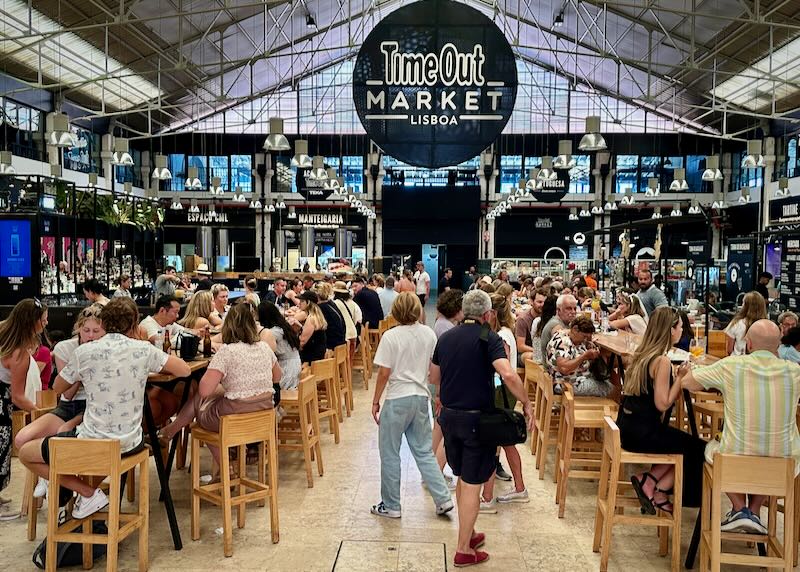
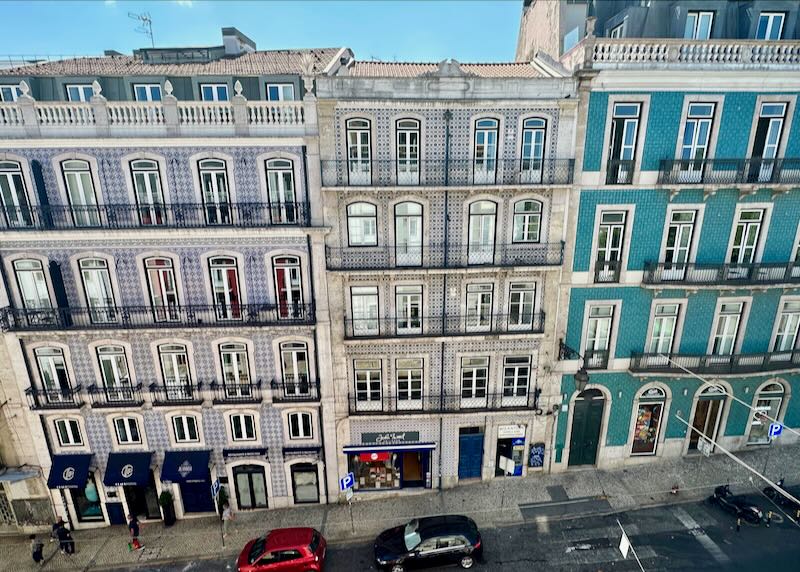

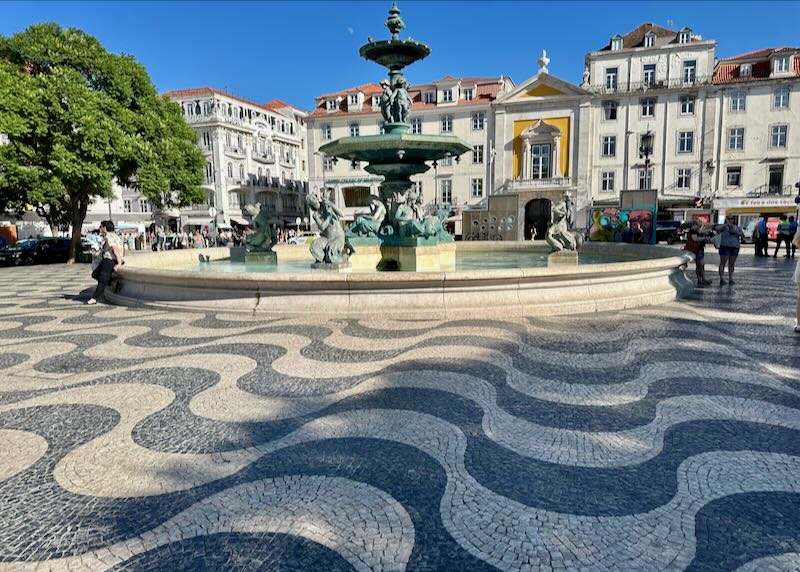
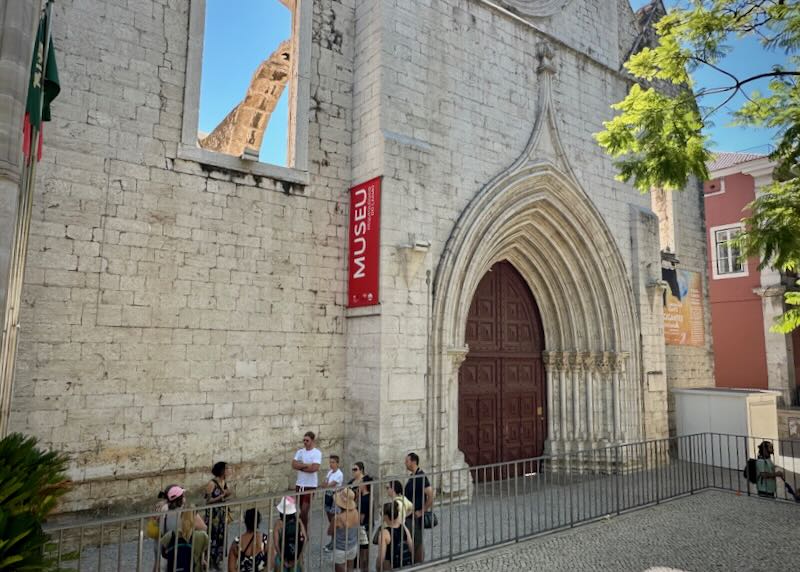

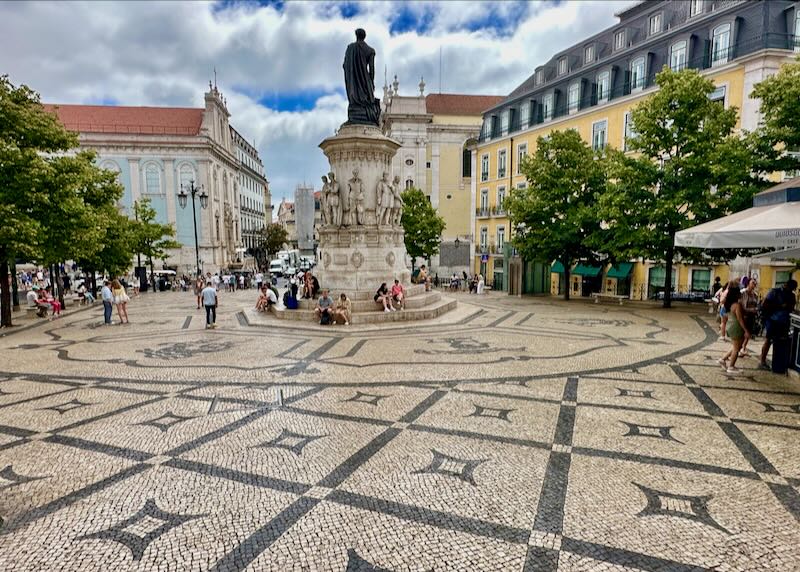
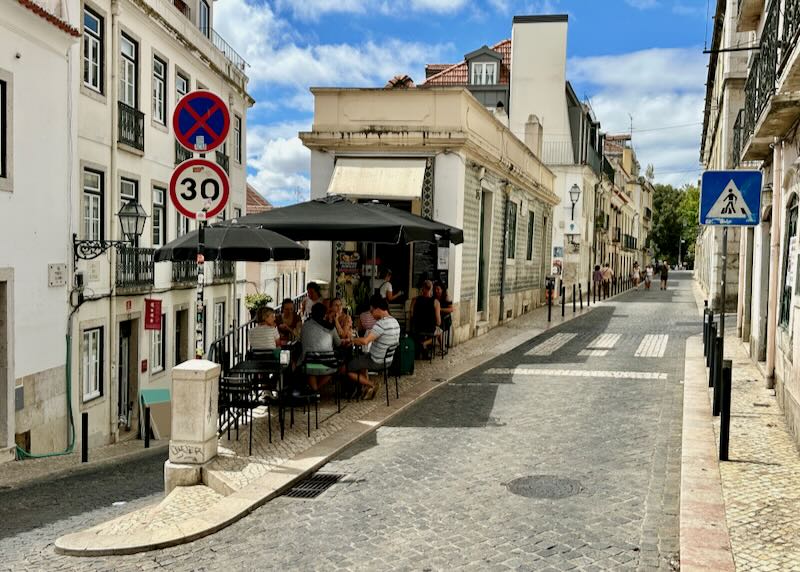

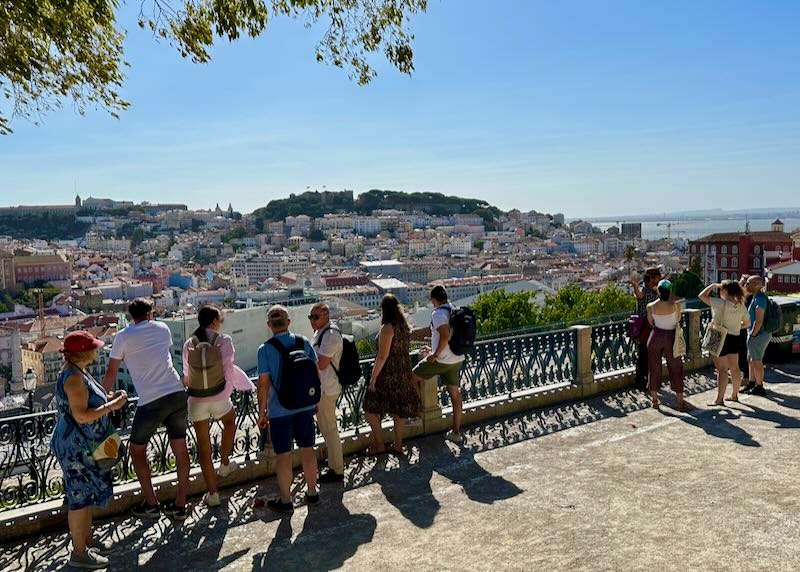
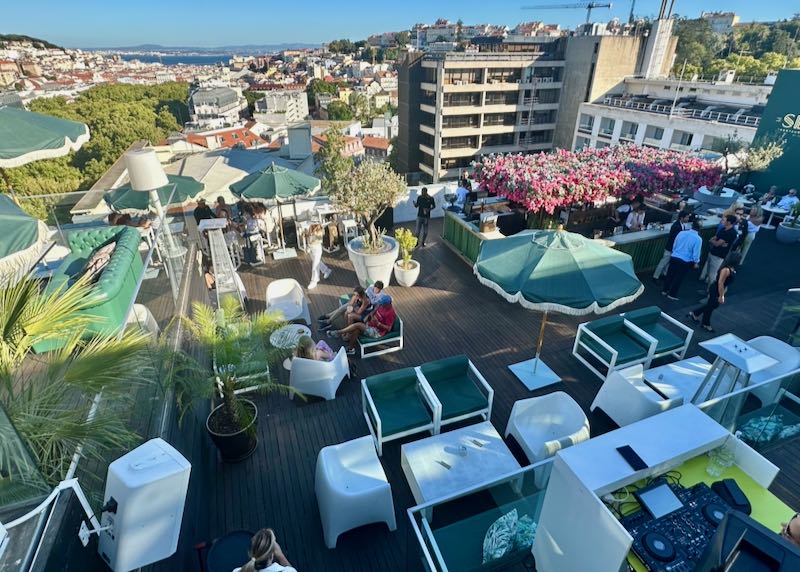

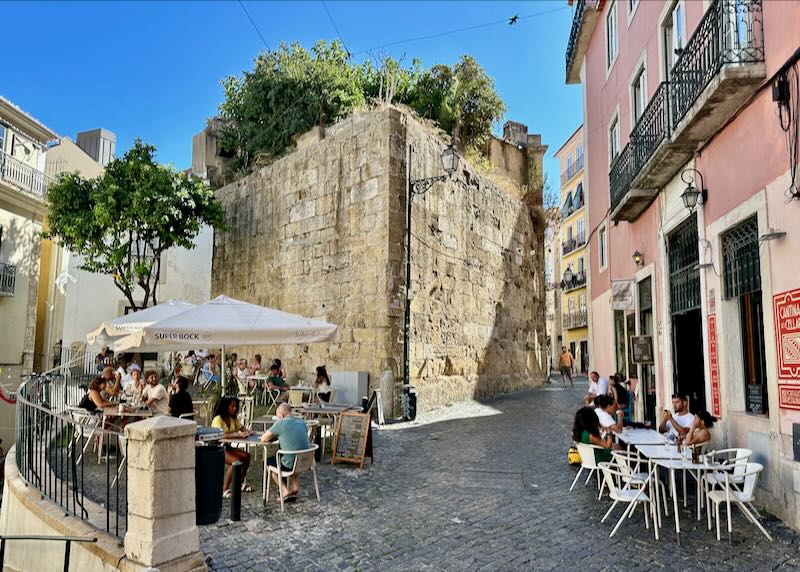

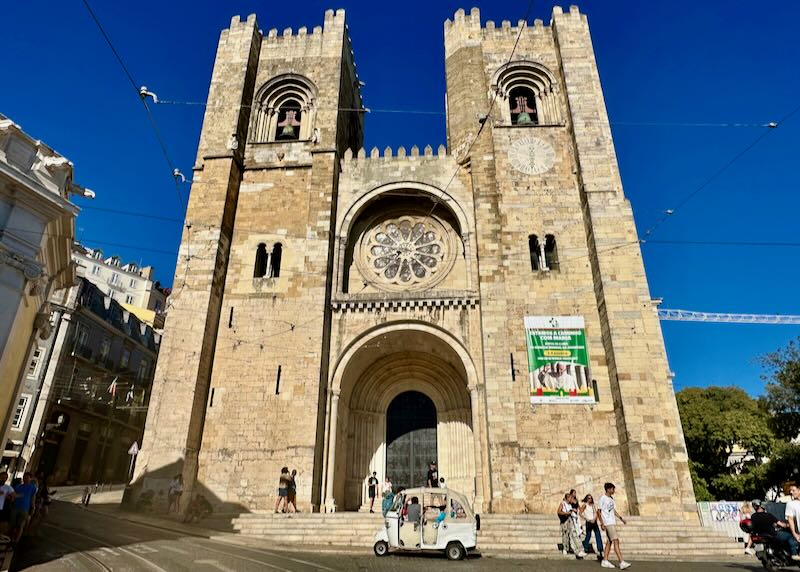
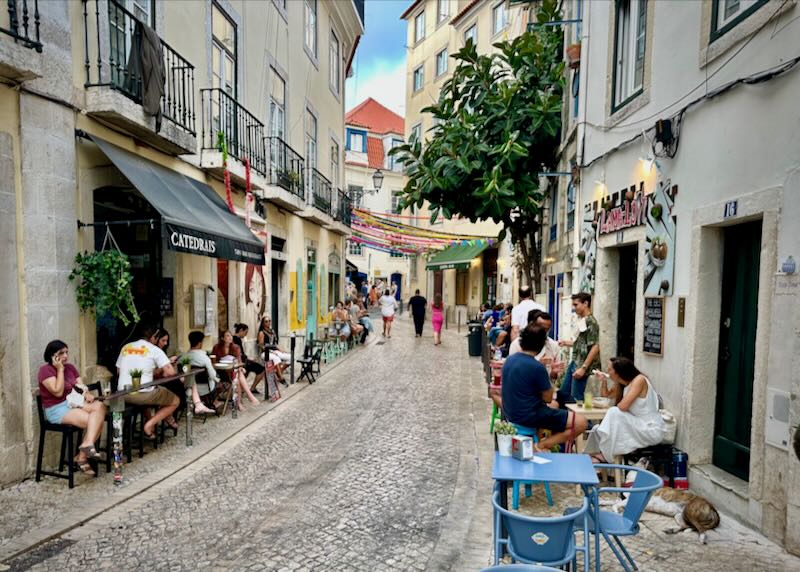


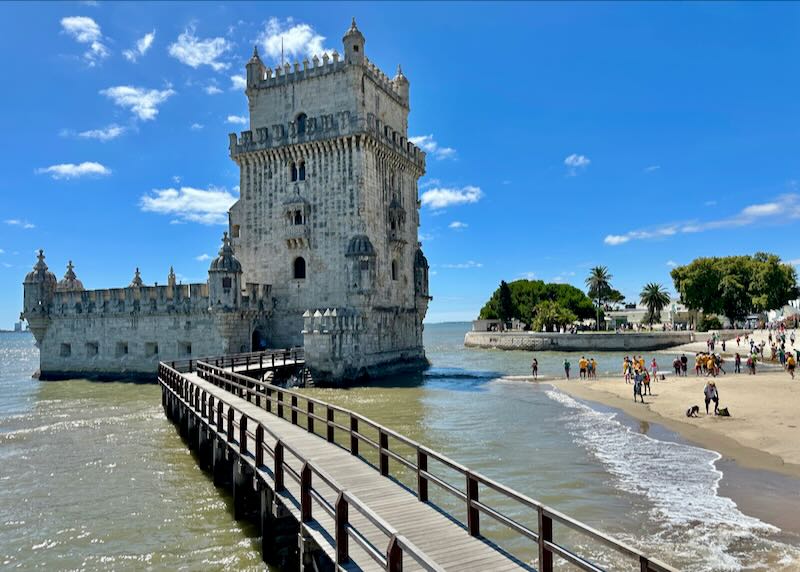

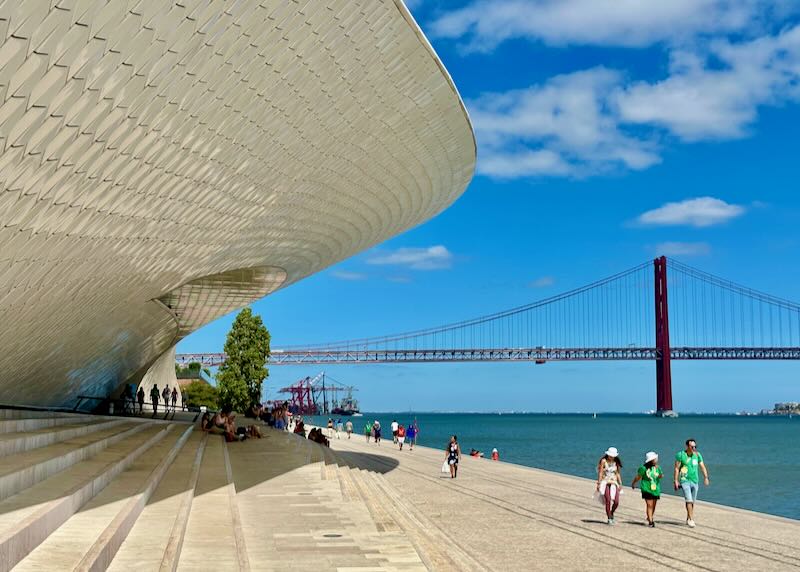
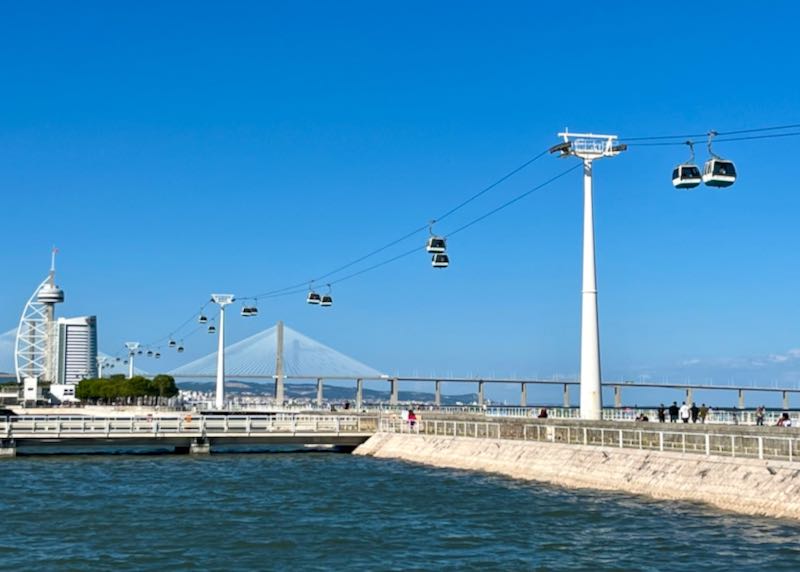

 Santorini Dave was started in 2011 when I posted a short guide to visiting Santorini with kids. Now, my site publishes regularly updated guides to
Santorini Dave was started in 2011 when I posted a short guide to visiting Santorini with kids. Now, my site publishes regularly updated guides to
Hey Dave, It would be a BONUS for me if you’d include hotel information that mentions if these have 24 hour front desk service or not. That is always important to me when traveling. Thanks for all you do.
Lisa Peurrung
That’s a great idea Lisa. Thanks for the feedback.
Brilliant post! I know Lisbon well and this info is surprisingly good.